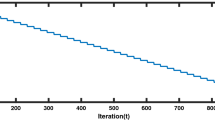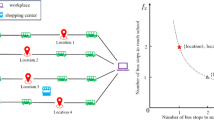Abstract
Evolutionary algorithms (EAs) have been successfully applied to solve numerous optimization problems. Neighborhood field optimization algorithm (NFO) has been proposed to integrate the neighborhood field in EAs, which utilizes local cooperation behaviors to explore new solutions. In this paper, certain new NFO variants are proposed based on the cooperation of descendent neighbors. The competitive and cooperative behaviors of NFO variants provide a remarkable ability to accelerate information exchanges and achieve global search. Experimental results show that NFO variants perform better than basic and other state-of-the-art EAs under different benchmark functions. For NFO and other EAs, it is difficult to quantify benefits of local cooperation in the optimization process. For this purpose, the cooperation behaviors are analyzed in a new network approach in this paper. In the proposed NFO variants, population graph shows a scale-free network with power-law distribution. Network characteristics, i.e., degree distribution, cluster coefficient and average degree, are used to quantify the cooperation behaviors. Experimental results show that network characteristics can effectively indicate the optimization performance of NFO variants in terms of convergence rate and population diversity. NFO variants with large cluster coefficients and significant heterogeneous characteristics can achieve a significant performance improvement on numerous problems.







Similar content being viewed by others
Explore related subjects
Discover the latest articles and news from researchers in related subjects, suggested using machine learning.References
Perego A, Perotti S, Mangiaracina R (2012) ICT for logistics and freight transportation: a literature review and research agenda. Int J Phys Distrib Logist Manag 41:457–483
Milgrom P, Roberts J (1990) The economics of modern manufacturing: technology, strategy, and organization. Am Econ Rev 80:511–528
Haijun Z, Xiong C, John KLH, Tommy WSC (2017) Object-level video advertising: an optimization framework. IEEE Trans Ind Inform 13:520–531
Vose MD (1999) The simple genetic algorithm: foundations and theory. IEEE Trans Evol Comput 4:191–192
Xu M, You X, Liu S (2017) A novel heuristic communication heterogeneous dual population ant colony optimization algorithm. IEEE Access 5:18506–18515
Chen WN, Zhang J (2013) Ant colony optimization for software project scheduling and staffing with an event-based scheduler. IEEE Trans Softw Eng 39:1–17
Shi Y, Eberhart RC (2005) A modified particle swarm optimizer. IEEE Conf Evol Comput 25:95–121
Jixiang C, Gexiang Z, Ferrante N (2013) Enhancing distributed differential evolution with multicultural migration for global numerical optimization. Inf Sci 247:72–93
Storn R, Price K (1997) Differential evolution: a simple and efficient heuristic for global optimization over continuous spaces. J Glob Optim 11:341–359
Wu Z, Chow T (2013) Neighborhood field for cooperative optimization. Soft Comput 17:819–834
Zhenan H, Gary GY, Zhang Y (2019) Robust multiobjective optimization via evolutionary algorithms. IEEE Trans Evol Comput 23:316–330
Eiben AE, Smith J (2015) From evolutionary computation to the evolution of things. Nature 521:476–482
Xiaoyu H, Yuren Z, Zefeng C (2019) Evolutionary bilevel optimization based on covariance matrix adaptation. IEEE Trans Evol Comput 23:258–272
Lynn N, Suganthan P (2013) Comprehensive learning particle swarm optimizer with guidance vector selection. In: IEEE symposium on swarm intelligence, pp 80–84
Gholamian M, Meybodi MR (2015) Enhanced comprehensive learning cooperative particle swarm optimization with fuzzy inertia weight (ECLCFPSO-IW). In: IEEE 2015 AI & robotics (IRANOPEN), pp 1–7
Azad A R, Jhariya D, Mohan A (2017) Synthesis of cross-coupled resonator filters using comprehensive learning particle swarm optimization (CLPSO) algorithm. In: IEEE Asia-Pacific microwave conference, pp 1–4
Han H, Lu W, Zhang L et al (2017) Adaptive gradient multiobjective particle swarm optimization. IEEE Trans Cybern 99:1–13
Deb A, Roy JS, Gupta B (2018) A differential evolution performance comparison: comparing how various differential evolution algorithms perform in designing microstrip antennas and arrays. IEEE Antennas Propag Mag 60:51–61
Chen Y, Luo F, Xu Y et al (2016) Self-adaptive differential approach for transient stability constrained optimal power flow. IET Gener Transm Distrib 10:3717–3726
Gao Z, Pan Z, Gao J (2016) Multimutation differential evolution algorithm and its application to seismic inversion. IEEE Trans Geosci Remote Sens 54:1–11
Cheng J, Zhang G, Caraffini F et al (2015) Multicriteria adaptive differential evolution for global numerical optimization. Integr Comput Aided Eng 22:103–107
Qin AK, Huang VL, Suganthan PN (2009) Differential evolution algorithm with strategy adaptation for global numerical optimization. IEEE Trans Evol Comput 13:398–417
Stuti C, Vishnu PS (2018) A modified genetic algorithm based on improved crossover array approach. Adv Data Inf Sci 39:117–127
Chao L, Qi Z, Bai Y et al (2019) Adaptive sorting-based evolutionary algorithm for many-objective optimization. IEEE Trans Evol Comput 23:247–257
Ye T, Ran C, Xingyi Z et al (2019) A strengthened dominance relation considering convergence and diversity for evolutionary many-objective optimization. IEEE Trans Evol Comput 23:331–345
YaHui J, WeiNeng C, Tianlong G et al (2019) Distributed cooperative co-evolution with adaptive computing resource allocation for large scale optimization. IEEE Trans Evol Comput 23:188–202
Xin F, Jurgen B, Nalan G (2019) New sampling strategies when searching for robust solutions. IEEE Trans Evol Comput 23:273–287
Tong Y, Zhong M, Li J et al (2018) Research on intelligent welding robot path optimization based on GA and PSO algorithms. IEEE Access 6:65397–65404
Ghamisi P, Benediktsson JA (2015) Feature selection based on hybridization of genetic algorithm and particle swarm optimization. IEEE Geosci Remote Sens Lett 12:309–313
Qin Y, Qin L, Li H (2012) Study on route optimization of logistics distribution based on ant colony and genetic algorithm. Int Symp Instrum Meas 1:285–288
Park J, Barabasi AL (2007) Distribution of node characteristics in complex networks. Proc Natl Acad Sci USA 104:17916–17920
Zhang H, Llorca J, Davis CC, Milner SD (2012) Nature-inspired self-organization, control, and optimization in heterogeneous wireless networks. IEEE Trans Mob Comput 11:1207–1222
Shouliang B, Bing-Hong W, Tao Z (2007) Gaining scale-free and high clustering complex networks. Phys A Stat Mech Appl 374:864–868
Barabasi AL, Oltvai ZN (2004) Network biology: understanding the cell’s functional organization. Nat Rev Genet 5:101–113
Boccaletti S, Latora V, Moreno Y, Chavez M, Hwang DU (2006) Complex networks: structure and dynamics. Phys Rep 424:175–308
Jordehi AR (2015) Enhanced leader PSO (ELPSO): a new PSO variant for solving global optimization problems. Appl Soft Comput J 26:401–417
Barzel B, Barabasi AL (2013) Universality in network dynamics. Nat Phys 9:673–681
Kennedy J, Mendes R (2002) Population structure and particle swarm performance. IEEE Congr Evol Comput 2:1671–1676
Dorronsoro B, Bouvry P (2011) Improving classical and decentralized differential evolution with new mutation operator and population topologies. IEEE Trans Evol Comput 15:67–98
Barabasi A (2009) Scale-free networks: a decade and beyond. Science 325:412–413
Xu L, Chow T (2010) Self-organizing potential field network: a new optimization algorithm. IEEE Trans Neural Netw 21:1482–1495
Khatib O (2003) Real-time obstacle avoidance for manipulators and mobile robots. IEEE Int Conf Robot Autom 2:500–505
Zhang X, Wu Z (2017) Study neighborhood field optimization algorithm on nonlinear sorptive barrier design problems. Neural Comput Appl 28:783–795
Sheikholeslami M, Gerdroodbary MB, Moradi R et al (2019) Application of neural network for estimation of heat transfer treatment of Al\(_2\)O\(_3\)–H\(_2\)O nanofluid through a channel. Comput Methods Appl Mech Eng 344:1–12
Sheikholeslami M, Sheykholeslami FB, Khoshhal S et al (2014) Effect of magnetic field on cu-water nanofluid heat transfer using GMDH-type neural network. Neural Comput Appl 25:171–178
Duncan JW, Per B (2000) Small worlds: the dynamics of networks between order and randomness. Phys Today 53:54–55
Bawden D (2004) Evolution and structure of the internet: a statistical physics approach, vol 128. Cambridge University Press, Cambridge, pp 449–452
Giabbanelli Philippe J (2011) The small-world property in network growing by active edges. Adv Complex Syst 14:853–869
Ohkubo J, Horiguchi T (2005) Scale-free property of optimal network for packet flow by a packet routing control. Phys A Stat Mech Appl 353:649–660
Fazekas I, Porvazsnyik B (2016) Scale-free property for degrees and weights in an N-interactions random graph model. J Math Sci 214:69–82
Matthias D, Frank ES, Yongtang S (2017) Quantitative graph theory: a new branch of graph theory and network science. Inf Sci 418:575–580
Bosiljka T (2002) Temporal fractal structures: origin of power laws in the world-wide web. Phys A Stat Mech Appl 314:278–283
Goldstein ML, Morris SA, Yen GG (2004) Problems with fitting to the power-law distribution. Eur Phys J B 41:255–258
Wasserman S, Faust K (1995) Social network analysis: methods and applications. Contemp Sociol 91:219–220
Watts DJ, Strogatz SH (1998) Collective dynamics of ‘small-world’ networks. Nature 393:440–442
Liang J, Qu BY, Suganthan PN (2013) Problem definitions and evaluation criteria for the CEC 2014 special session and competition on single objective real-parameter numerical optimization. Zhengzhou University, Computational Intelligence Laboratory, Zhengzhou
Acknowledgements
This work was supported by the National Natural Science Foundation of China (61803054, 61673190), the Fundamental Research Funds for the Central Universities (2019CDQYZDH030, 106112017CDJXY170003) and the Graduate Scientific Research and Innovation Foundation of Chongqing, China (CYB18064).
Author information
Authors and Affiliations
Corresponding author
Ethics declarations
Conflict of interest
The authors declare that they have no conflict of interest. The article is considered for publication on the understanding that the article has neither been published nor will be published anywhere else before being published in the journal of Neural Computing and Applications.
Additional information
Publisher's Note
Springer Nature remains neutral with regard to jurisdictional claims in published maps and institutional affiliations.
Appendix
Appendix
1.1 Introduction to the IEEE-CEC 2014 benchmark suite
IEEE-CEC 2014 includes 30 benchmark functions as follows: unimodal functions (\({{F_1}-{F_3}}\)), simple multimodal functions (\({{F_4}-{F_{16}}}\)), hybrid functions (\({{F_{17}}-{F_{22}}}\)) and composition functions (\({{F_{23}}-{F_{30}}}\)). In this “Appendix”, I will list the details of functions ( \({F_1}\), \({F_4}\), \({F_{17}}\) and \({F_{23}}\) ) which come from unimodal functions, simple multimodal functions, hybrid functions and composition functions, respectively. The details of other functions are shown in the literature [56].
Rotated High Conditioned Elliptic Function: \({F_1}\)
note:
\({{F_1^*} = 100}\)
\({{f_1({\mathbf{x }})} = {\sum \nolimits _{i = 1}^D {(10^6)^{\frac{i-1}{D-1}} x_i^2}}}\)
Shifted and Rotated Rosenbrock’s Function: \({F_4}\)
note:
\({{F_4^*} = 400}\)
\({{f_4({\mathbf{x}} )} = {\sum \nolimits _{i = 1}^{D-1} {(100({x_i^2} - {x_{i+1}})^2 + ({x_i} - 1)^2)}} }\)
Hybrid Function 1\({(N=3)}\): \({F_{17}}\)
note:
-
\({{F_{17}^*} = 1700}\)
-
\({p=[0.3, 0.3, 0.4]}\) is used to control the percentage of \({g_i({\mathbf{x }})}\)
-
\({g_1}\): Modified Schwefel’s Function
-
\({g_2}\): Rastrigin’s Function
-
\({g_3}\): High Conditioned Elliptic Function
-
\({{\mathbf{z }_1} = {[\mathbf{y }_{S_1}, \mathbf{y }_{S_2}, \mathbf{y }_{S_{n_1}} ]}}\)
-
\({{\mathbf{z }_2} = {[\mathbf{y }_{S_{n_1+1}}, \mathbf{y }_{S_{n_1+2}}, \mathbf{y }_{S_{n_1+n_2}} ]}}\)
-
\({{\mathbf{z }_3} = {[\mathbf{y }_{S_{n_1+n_2+1}}, \mathbf{y }_{S_{n_1+n_2+2}}, \mathbf{y }_{S_{n_1+n_2+n_3}} ]}}\)
-
\({{n_N} ={D-\sum \nolimits _{i = 1}^{N-1}{n_i} } }\)
-
\({{\mathbf{y }} = {{\mathbf{x }}-\mathbf{o }_i} }\)
-
\({{S} = {randperm(1:D)} }\)
Composition Function 1\({(N=5)}\): \({F_{23}}\)
note:
-
\({{F_{23}^*} = 2300}\)
-
\({\sigma =[10, 20, 30, 40, 50]}\)
-
\({\lambda =[1, 1e-6, 1e-26, 1e-6, 1e-6]}\)
-
\({bias=[0, 100, 200, 300, 400]}\)
-
\({g_1}\): Rotated Rosenbrock’s Function
-
\({g_2}\): High Conditioned Elliptic Function
-
\({g_3}\): Rotated Bent Cigar Function
-
\({g_4}\): Rotated Discus Function
-
\({g_5}\): High Conditioned Elliptic Function
-
\({{\omega _i} = {\frac{1}{\sqrt{\sum \nolimits _{j = 1}^{D}{(x_i-o_{ij})^2}}} exp(- \frac{\sum \nolimits _{j = 1}^{D}{(x_i-o_{ij})^2}}{2 D \sigma _i^2}) } }\)
Please note: All test functions are minimization problems; the details of mutual parameters are shown as following:
search range: \({[-100, 100]^D}\)
-
D: dimensions
-
\({{\mathbf{x }}=[x_1,x_2,,...,x_D]^T}\)
-
\({\mathbf{o }_{i1}=[o_{i1},o_{i2},,...,o_{iD}]^T}\): the shifted global optimum, which is randomly distributed in \({[-80, 80]^D}\).
-
\({\mathbf{M }_i}\): rotation matrix, and it for each subcomponents is generated from standard normally distributed.
Rights and permissions
About this article
Cite this article
Ao, N., Zhao, M., Li, Q. et al. Network characteristics for neighborhood field algorithms. Neural Comput & Applic 32, 12061–12078 (2020). https://doi.org/10.1007/s00521-019-04255-0
Received:
Accepted:
Published:
Issue Date:
DOI: https://doi.org/10.1007/s00521-019-04255-0




